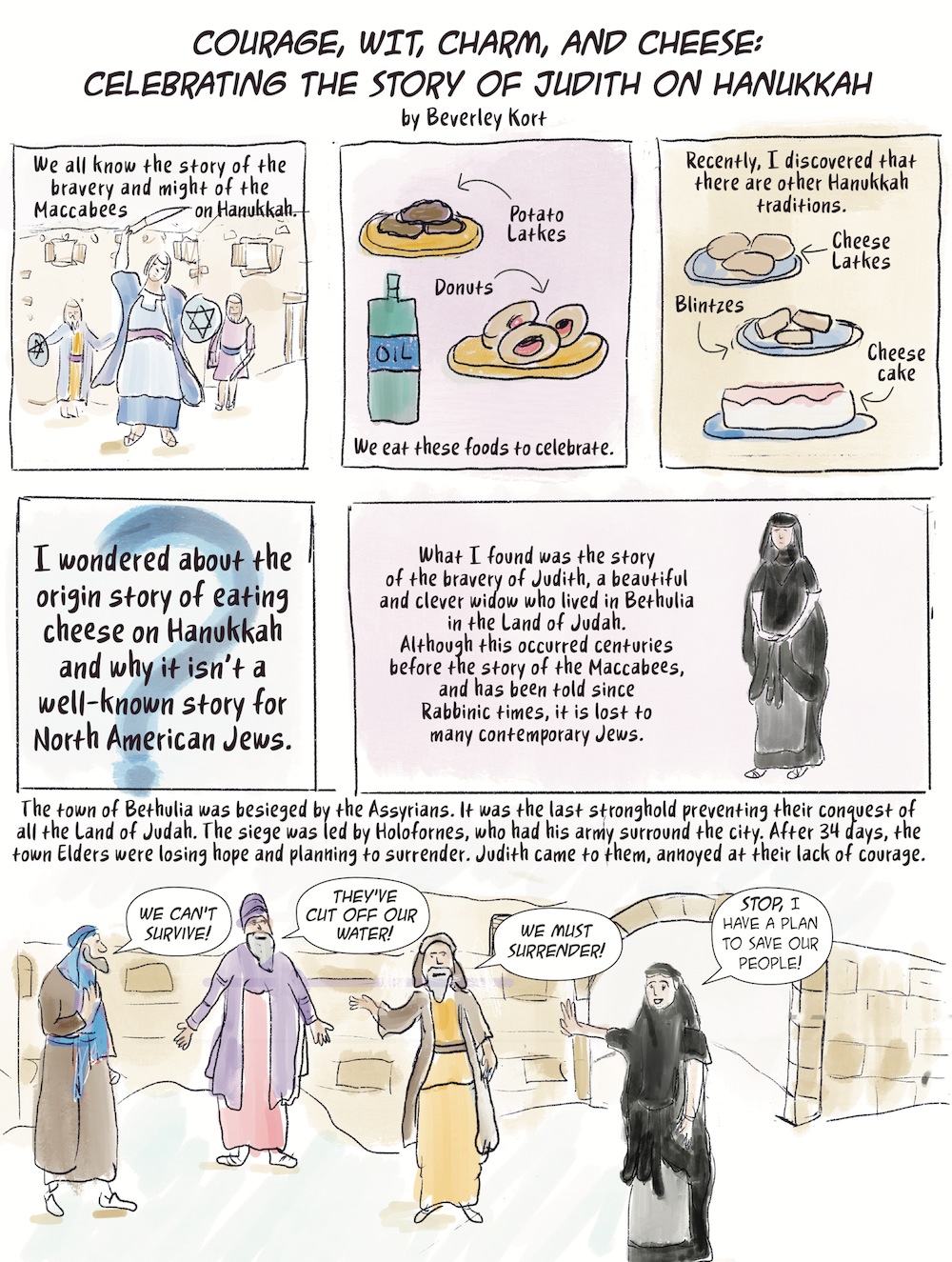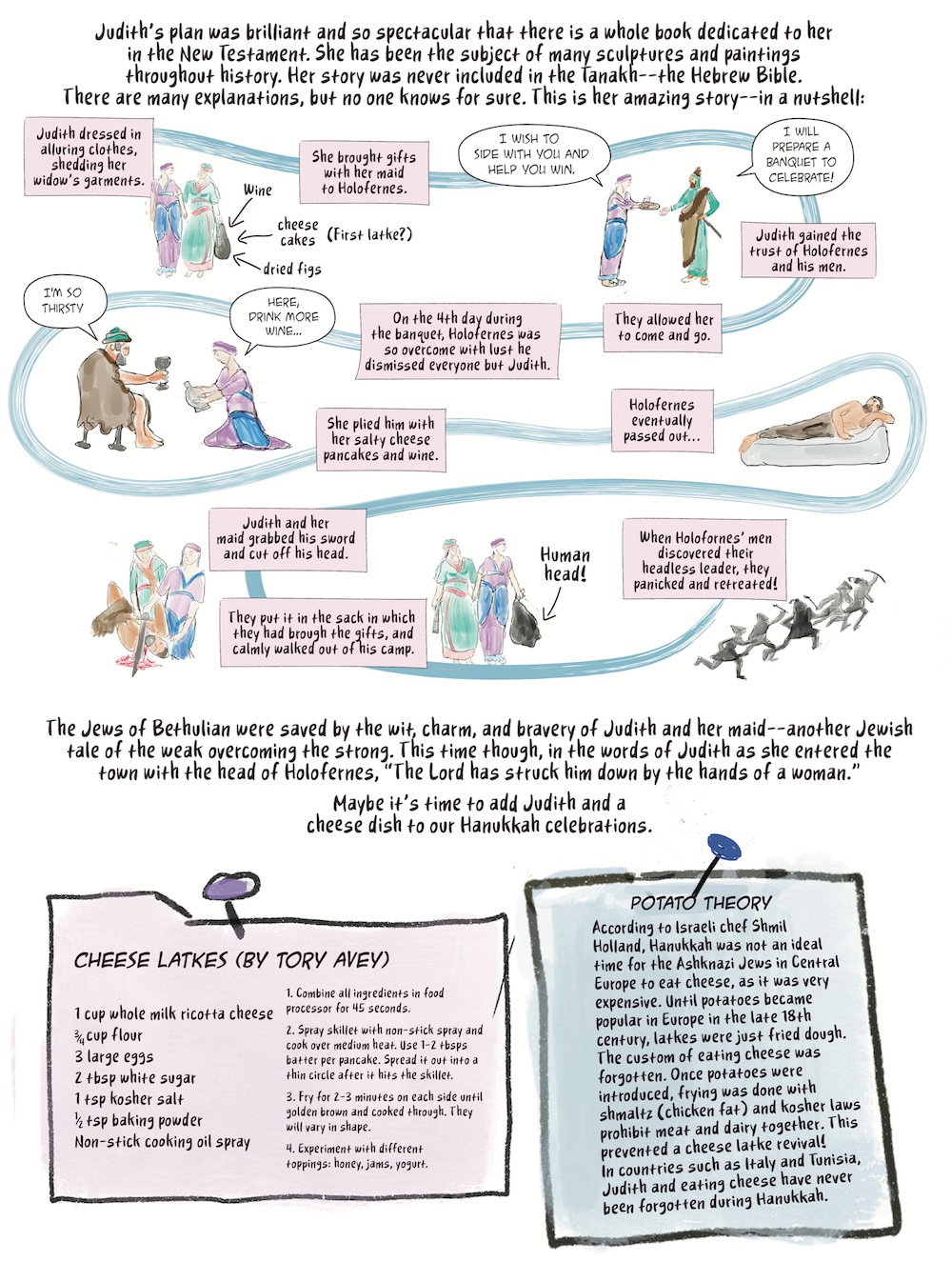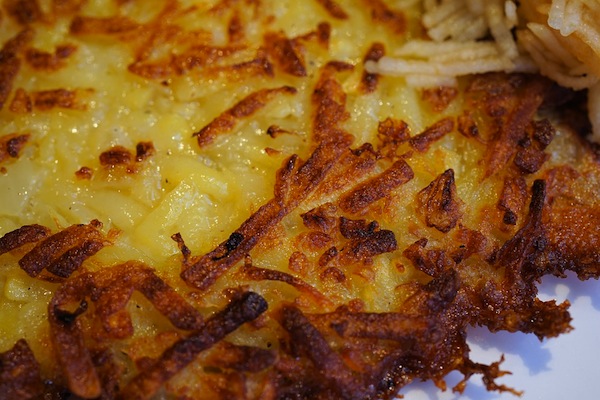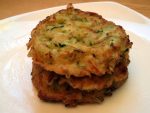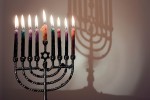Beverley Kort is a registered psychologist by day and a cartoonist in her off hours. She has a private practice in Vancouver.
Tag: latkes
Variations on latke tradition
With all the oil used for frying Chanukah potato pancakes – otherwise known as latkes, in what we think is Yiddish, or as levivot in Hebrew – they may be considered an unhealthy food. Yet, each Chanukah, many of us, who are staunch-hearted and old-fashioned, spend time grating potatoes by hand, always accidentally suffering at least one scraped finger. The more modern among us risk coming out with liquid mush by using a food processor or blender.
Why do we keep making these little pancakes year after year? Why do we eat them for Chanukah in the first place? An old folk proverb says: “Chanukah latkes teach us that one cannot live by miracles alone.”
Jewish food writer and cookbook author Joan Nathan contends that the word latke is not in fact Yiddish but rather stems from “a Russian word, latka, and a pastry, from obsolete Russian, oladka, or flat cake of leavened wheat dough.” This, in turn, probably came from a Middle Greek word, eladion, or oil cake, stemming from elaion, meaning olive oil.
Potato pancakes seem to have originated among poor Eastern European Jews, but potatoes did not become a staple until the mid-19th century. John Cooper, in Eat and Be Satisfied: A Social History of Jewish Food, comments that Jews from Lithuania ate pancakes made from potato flour for Chanukah and had borrowed the idea from Ukrainians, who made a potato pancake dish with goose fat called kartoflani platske, which they ate for Christmas. Since Chanukah fell about the same time, and there were plenty of geese to provide goose fat or schmaltz, we could conclude that schmaltz became a substitute for oil. Jews living in the Pale of Settlement in the 17th century probably adapted it for Chanukah as a way to dress potatoes differently for the holiday. Cooper also states that many Eastern European Jews ate buckwheat latkes for Chanukah, while Polish Jews made placki, pancakes, from potato flour and fried them in oil.
Here are a few types of latkes that would be nice to serve during Chanukah.
ROMANIAN ZUCCHINI POTATO LATKES
(six to eight servings)
2 pounds zucchini, peeled and grated down to the seeds
2 large potatoes, grated
1 medium onion, grated
3 eggs
1 tsp vegetable oil (I use canola)
3/4 cup matzah meal (I use flour)
salt and pepper to taste
vegetable oil for frying
- Grate zucchini down to the seeds, discard the seeds and squeeze out the liquid.
- Peel potatoes and grate. Remove liquid.
- Grate onion and add to zucchini-potato mixture.
- Add eggs, oil and half a cup of matzah meal or flour. Add more if necessary.
- Season with salt and pepper.
- Heat oil in a frying pan. Spoon mixture into pan and brown on both sides.
- Serve hot with sour cream or applesauce. You can add carrots, parsley and dill.
TUNA LATKES
This recipe came from Starkist Tuna, with adaptations. It makes 16 latkes.
2 cans drained tuna
2 grated potatoes
1 chopped onion
2 eggs
2 tbsp breadcrumbs
3 tsp dry parsley flakes
3 tsp dry chives
salt and pepper to taste
2/3 cup flour
oil
dressing
1 cup sour cream
3 crushed garlic cloves
4 tbsp olive oil
6 tsp dry herbs such as chives, thyme or dill or mixed
1 tbsp sugar
salt to taste
- In a bowl or jar with a lid, mix sour cream, garlic, oil, herbs, sugar and salt. Refrigerate.
- Heat oil in a frying pan and fry onions until golden.
- Crumble tuna in a bowl. Add potatoes, onion, eggs, breadcrumbs, parsley, chives, salt and pepper.
- Place flour in a shallow plate. Form round patties and dip in flour. Add oil to frying pan. Fry patties until golden. Drain on paper towels.
- Serve on a platter with dressing on the side.
HERBED ZUCCHINI FETA LATKES
With a few changes, this recipe is from Food & Wine and is by Didem Senol, a chef from Istanbul, Turkey, who trained at the New York French Culinary Institute. It makes four to six servings.
4 medium grated zucchini
1 tbsp kosher salt
2 large eggs
1/2 cup flour
1/2 cup chopped dill
1/4 cup chopped parsley
1/2 cup crumbled feta cheese
sauce
1 seeded chopped, peeled cucumber
1 cup sour cream
salt and pepper to taste
vegetable oil
- Place zucchini in a colander, sprinkle with salt, toss and let stand five minutes. Squeeze out liquid and transfer to a bowl.
- Add eggs, flour, dill, parsley and feta. Refrigerate 10 minutes.
- Puree cucumber in food processor and transfer to a bowl. Stir in sour cream, salt and pepper.
- Preheat oven to 350°F. Heat oil in a frying pan and then, working in batches, drop tablespoons of batter into the hot oil and fry until brown and crisp. Transfer to a baking sheet and keep warm in oven.
- Serve with sour cream-cucumber sauce.
Sybil Kaplan is a journalist, lecturer, book reviewer and food writer in Jerusalem. She created and leads the weekly English-language Shuk Walks in Machane Yehuda, she has compiled and edited nine kosher cookbooks, and is the author of Witness to History: Ten Years as a Woman Journalist in Israel.
Alternatives to potato latkes
(photo from Joy/flickr.com)
An old folk proverb says, “Chanukah latkes teach us that one cannot live by miracles alone.”
Jewish food writer and cookbook author Joan Nathan contends that the word latke is not Yiddish, as everyone presumes, but stems from “a Russian word, latka, and a pastry, from obsolete Russian, oladka, or flat cake of leavened wheat dough.” This, in turn, probably came from a Middle Greek word, eladion, or oil cake, stemming from elaion, meaning olive oil.
Potato pancakes do seem to have originated among poor Eastern European Jews, but potatoes did not become a staple until the mid-19th century. John Cooper, in Eat and Be Satisfied: A Social History of Jewish Food, comments that Jews from Lithuania ate pancakes made from potato flour for Chanukah and had borrowed the idea from the Ukrainians, who made a potato pancake dish with goose fat called kartoflani platske, which they ate for Christmas. Since Chanukah fell about the same time, and there were plenty of geese to provide goose fat or schmaltz, we could conclude that schmaltz became a substitute for oil. Jews living in the Pale of Settlement in the 17th century probably adapted it for Chanukah as a way to dress potatoes differently for the holiday. Cooper also states that many Eastern European Jews ate buckwheat latkes for Chanukah, while Polish Jews made placki (pancakes) from potato flour and fried them in oil.
But what happens when you get tired of potato latkes? Here are some variations for Chanukah.
OLD JERUSALEM ZUCCHINI PANCAKES
Adapted from The Delights of Jerusalem by Rena Valero (Steimatzky, 1985). Recipe makes 20 patties.
6 zucchini
salt, to taste
salt and pepper to taste
1 diced onion
2 tbsp chopped parsley
2 tbsp chopped dill
2 large eggs
1/2 cup matzah meal
1 tbsp vegetable oil
oil for frying
- Grate unpeeled zucchini into a strainer. Sprinkle with salt and drain for 30 minutes. Squeeze to remove remaining liquid.
- In a mixing bowl, combine zucchini, salt, pepper, onion, parsley, dill, eggs and matzah meal and one tablespoon oil.
- Heat oil in a frying pan. Form zucchini mixture into patties. Fry for a few a minutes on each side. Drain on paper towels.
CARROT-PARSNIP LATKES
makes 16 patties
5 grated parsnips
2 grated carrots
1/4 cup flour
2 eggs
1 tsp dry chives or onion
1 tsp dry parsley
1/2 tsp salt
oil
- Grate parsnips and carrots into a mixing bowl and toss with flour.
- Add eggs, chives or onion, parsley and salt and mix.
- Heat oil in a frying pan. Make latkes by hand, add to oil, and fry until brown on both sides. Drain on paper towels.
VEGETABLE FETA LATKES
makes 10 to 12 patties
1 cup grated carrots
2 1/2 cups grated zucchini
1 cup grated potatoes or grated kohlrabi
1/2 tsp salt
3 eggs
salt and pepper to taste
3/4 cup flour
1/2 cup chopped fresh parsley
1/2 cup crumbled feta cheese
1/5 cup vegetable oil
- Place carrots, zucchini and potato (or kohlrabi) in a colander. Cover with cheesecloth or paper towels and squeeze out as much liquid as possible. Sprinkle salt and let them drain 15 minutes, then squeeze in paper towels.
- Place vegetables in a mixing bowl. Add eggs, salt and pepper, flour, parsley and cheese.
- Heat oil in a frying pan. Form mixture into patties. Fry in hot oil until brown on both sides. Drain on paper towels.
Applesauce & sour cream
Recently, someone asked me, why applesauce and sour cream for latkes? I wrote to my American Jewish food expert friend, Joan Nathan, but she didn’t know, so I Googled latkes and applesauce, found a blogger who voiced an idea, and I thought it made sense.
He suggested that, maybe, one year before Chanukah, a shopkeeper somewhere in Eastern Europe placed his annual order for potatoes to his dry goods provider. He wrote potatoes in Hebrew as tapuah adama. Somehow, the word adama was inadvertently erased and ended up being tapuach, the Hebrew word for apple. The supplier read the order and scratched his head, wondering why the shopkeeper didn’t want potatoes for Chanukah. But, due to the limits of communication back in those days, he couldn’t check with him in time, so he went ahead and filled the order, sending a bushel of apples.
When the shopkeeper saw the apples instead of potatoes, he wondered what to do with them but then figured, surely they would be a treat for Chanukah. He was able to sell the idea to the townspeople to buy apples, and some clever women decided to cook the apples – hence, applesauce. By the end of the holiday, everyone was raving about the apples and apple dishes.
In the Encyclopedia of Jewish Food, Gil Marks wrote that Greek Jews had a tradition that the Maccabees ate duck with apples to celebrate their victory, and that this was extended to serving apple rings, apple fritters and applesauce.
John Cooper, in Eat and Be Satisfied, reasons that the only fat for frying latkes was schmaltz, so the only topping could be applesauce.
Another source says apples were eaten on Rosh Chodesh, the start of a new month. Hungarian Jews made apple cake and strudel or tart for Rosh Hashanah, while Indian Jews dip apple in honey and rose water and Sephardi Jews make apple compote. Ashkenazi Jews serve apple strudel on Sukkot, and children place apples at the end of a flag stick for Simchat Torah.
As for sour cream, well, made in its fermented form, it was popular in the Slavic region. The idea of boiled potatoes eaten with sour cream was associated with Eastern European Jews, so, if they found a substitute for the schmaltz when frying their latkes, they could well have used sour cream as an accompaniment.
Sybil Kaplan is a journalist, author, compiler/editor of nine kosher cookbooks and a food writer for North American Jewish publications, who lives in Jerusalem where she leads weekly walks of the Jewish food market, Machaneh Yehudah, in English.
Mother influences chef
The New Kosher: Simple Recipes to Savor and Share by Kim Kushner is a beautiful cookbook with more than 100 recipes that reflect many cultural traditions. There are full-color photos aplenty (by Kate Sears), easy-to-follow instructions, and each recipe has its own brief introduction.
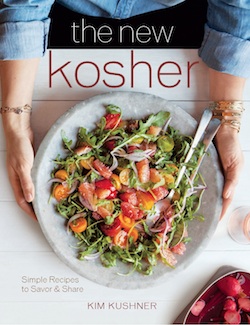 Kushner’s bio notes that she spent “childhood summers in Israel with her extended family,” and there “learned to cook by eating, and by participating in family feasts.” In The New Kosher, she writes: “I was raised in a modern Orthodox home in a vibrant kosher community in Montreal and first learned to cook from my mother, who was born in Morocco and grew up in Israel. My mother’s life revolves around food, and her generosity through her love of feeding other people has been the greatest influence on my cooking.”
Kushner’s bio notes that she spent “childhood summers in Israel with her extended family,” and there “learned to cook by eating, and by participating in family feasts.” In The New Kosher, she writes: “I was raised in a modern Orthodox home in a vibrant kosher community in Montreal and first learned to cook from my mother, who was born in Morocco and grew up in Israel. My mother’s life revolves around food, and her generosity through her love of feeding other people has been the greatest influence on my cooking.”
Now living in New York with scads of education and experience behind her, including the cookbook The Modern Menu (2013), there can be no doubt that the meals, salads, appetizers and desserts in The New Kosher will make for good eating – and for good sharing with family and friends.
Since it’s almost Chanukah, here are two recipes from the book, one for latkes and one for an applesauce that would go with them quite nicely or, as Kushner recommends: “It’s delicious on its own or served alongside roasted potatoes or even sliced brisket, and both kids and adults love it.”
KIM’S QUICK LATKES
(makes about 24)
5 Yukon gold or red potatoes, about 2 lb (1 kg) total weight, peeled and cut into large chunks
1 large yellow onion, cut into large chunks
2 large eggs
1⁄3 cup (2 oz/60 g) all-purpose flour
1 tsp baking powder
kosher salt and freshly ground pepper
1⁄2 cup (4 fl oz/125 ml) rice bran
oil or canola oil
Preheat the oven to 400°F.
In a food processor, combine the potatoes, onion and eggs, and process with quick on-off pulses until the potatoes and onion are chopped into small pieces, about 30 seconds. Add the flour, baking powder, one teaspoon salt and 1⁄4 teaspoon pepper and process until the ingredients are well combined, a couple of seconds longer.
In a large frying pan, heat the oil over medium-high heat. Using an ice-cream scoop … scoop up the potato mixture, drop into the hot oil, and flatten with a spatula or fork to about 1⁄4–1⁄2 inch thick. Cook only four latkes at a time so you don’t crowd the pan. Once the edges are browned, carefully flip the latkes over and cook until the underside is crisp and golden, about two minutes per side. Transfer the latkes to paper towels to drain. Repeat with the remaining potato mixture. You can serve them right away, but Kushner likes to arrange them in a single layer on a baking sheet and put them in the oven for three to five minutes to give them a final crisping.
To freeze the latkes, let them cool completely, then freeze them in a single layer in large lock-top plastic freezer bags for up to one month. To serve, thaw in the refrigerator overnight and reheat in a 375°F oven until piping hot, eight to 10 minutes.
If you like, sprinkle the latkes with truffle salt just as they come out of the frying pan but, if you plan to do this, reduce the kosher salt to 1⁄2 teaspoon.
VANILLA BEAN APPLESAUCE
(makes 3-4 cups)
10–15 apples (any variety), 3.5–4 lb (1.75–2 kg) total weight, peeled, quartered and cored
1 vanilla bean, split lengthwise
In a large pot, combine the apples, vanilla bean and 1⁄4 cup water and bring to a boil over high heat. Reduce the heat to medium, cover and cook for 35-50 minutes without stirring. (The water will prevent the apples from scorching.) The timing will depend on how many apples you use: the more fruit, the longer the mixture will need to cook. To test for doneness, pierce the apples with a fork. They should be extremely soft and almost falling apart.
Carefully remove the vanilla bean from the pot and let it cool for a few minutes. Then, using the tip of a sharp knife, scrape the seeds into the pot and discard the pod.
Let the apple mixture cool for about five minutes longer. If you prefer a smooth applesauce, transfer the mixture, in batches, to a food processor, and pulse until smooth. If you prefer a chunky sauce, use a potato masher to mash the fruit to your desired consistency. Let cool completely, then transfer to one or more glass jars. The applesauce will keep in the fridge for up to two weeks.
For the long love of latkes
A Google search for latke recipes reveals 341,000 results, so popular is the Chanukah treat.
My earliest memory of Chanukah catapults me back to Winnipeg’s North End of the 1940s and my grandparents’ cozy, clapboard house on the tree-lined boulevard of Burrows Avenue East. My mother and I lived there then; my father was still away at war. It was the time in a child’s life before words, when smells and sounds and tastes made meaning of the world. Although I couldn’t say latke, much less describe its savory, greasy goodness or its mouth-watering fragrance, I knew what it was with every fibre and neuron of my little being, and could hardly wait for my grandmother to place a warm, tiny morsel into my impatient mouth.
My aproned baba, spatula in hand, bent over the sizzling frying pan in the over-crowded kitchen, flipping the golden discs of shredded potato and onion like a juggler. The tantalizing odor rising from the stove told me that Chanukah was near. My grandmother would make frying pan after frying pan of latkes, stacking them in her large roasting pan, the only container large enough to store the hundreds of latkes she churned out. I knew, once the covered roaster found its way into the old Leonard refrigerator with the compressor on the top, that Chanukah was only a day or two away.
And, joyfully, now Chanukah is almost here again. Though more than 65 years have passed since that first delicious bit of latke found its way into my waiting, toothless mouth, the visions of that kitchen and the image of my beloved grandmother, who has been gone for 31 years now, are as clear as they were then, the taste and the smell just as vivid. And to celebrate, it’s time to pay tribute to the wonderful latke, the traditional Chanukah staple. If we take a look on the internet, we discover the potato latke and its many oily variations listed innumerable times. Even kitchen diva Martha Stewart has her own special recipes posted on her website – 16 at last count. (She also has other sections dedicated to the holiday that are worth checking out.)
When Rabbi Marc Gellman from Toronto appeared on the TV show Good Morning America many years ago to talk about Chanukah, he shared a basic recipe for latkes, with one difference – the addition of nutmeg. He also shared his secret to good apple sauce: “Core but do not peel about eight Mutsu or Rome apples. Cook with one-quarter cup of apple cider and a cinnamon stick.”
If you ever tire of the traditional potato latke, don’t despair. Believe it or not, there is the Jewish Food Experience latke archives to consult. More than 100 varieties can be found there to tempt you, including drunken apple, walnut, cauliflower-cheddar, Sephardi bunuelos, and dozens more, such as chestnut flour, risotto, and Norwegian lox. But I think I’ll pass on the brain latkes!
What to do if you love latkes, but not the fat? The Canadian Cancer Foundation suggests trying a no-oil “lean” latke. Coat a skillet with fat-free cooking spray and smooth the grated potatoes into a large, plate-sized pancake. One serving contains 162 calories and less than one gram of fat. And, if a latke just isn’t a latke without oil, then go ahead and splurge by adding one tablespoon only.
Every year, amateur cook Roger Mummert holds court in his Long Island kitchen for chefs with the tastiest and most extreme latke recipes. Last year, the event was covered by National Public Radio, which archived its report along with recipes for winners, including Larry’s firecracker latke poppers, spana-latke-kopita, and Mexi-latkes with jalapenos and red peppers.
There are many websites that give recipes on how to make a great latke. At the All Recipes site, there are tips about what kind of potatoes to use (russet), how to keep them from turning pinkish-brown (keep them under water) and how to make sure they don’t fall apart when you’re frying them (squeeze the potato mixture in a cheesecloth).
Who would have imagined that there’s also a whole sub-genre of latke humor lurking on the web? In his article “Ritual slaughter of the latke,” Raphael Finkel elucidates the intricate (and phony) Jewish laws that ensure that latkes are kosher. For example, just as kosher meat must be salted, Finkel says we must “remember to salt the potato and leave it to drain for at least 24 hours. We do this in memory of Lot’s wife, Latke, who was turned to salt. Use a lotta salt, in memory of Lot’s daughter, Lotta.” Is that a groaner, or what?
Believe it or not, a scholarly book titled Desperately Seeking Certainty: The Misguided Quest for Constitutional Foundations has a recipe in it for potato latkes. Honest! The authors use that as a starting point to envisage how that recipe might be reinterpreted by leading jurists like retired U.S. Supreme Court justice Antonio Scalia. “Scalia would conclude that latkes were a liberal distortion of the recipe as originally understood, so he would make matzah (unleavened bread ritually eaten at Passover) instead.” Meanwhile, the heavy thinkers at MIT engage in an annual food fight on the same weighty subject.
Speaking of weight, I’ll leave the last word to writer Marjorie Windgall, whose wishes for a modern-day Chanukah miracle are probably shared by latke fans everywhere. She quips, “My hope is that a miracle will occur and the calories of eight days will count as the calories of one.” Me, too!
Sharon Melnicer is a Jewish freelance writer, broadcaster and artist living in Winnipeg.
Latke, latka: ‘cause it’s tradition!
Latkes are a simple yet delicious holiday treat. Try baking instead of frying, or dress them up with dill sauce and fish. (photo by Barry A. Kaplan)
They’re sometimes greasy, sometimes salty and soggy, and they are fried in oil. They’re high in calories, sometimes; high in fat, sometimes; high in cholesterol, sometimes. But they’re oh, so good! What are they? They’re potato pancakes, otherwise known as latkes (or latkas), in what we believe to be Yiddish, or as levivot in Hebrew.
With all the oil used for frying, traditional latkes may be considered an unhealthy food. Yet, each Chanukah, many of us who are staunch-hearted and old-fashioned spend time hand-grating potatoes (nearly always accidentally suffering at least one scraped knuckle). The more modern among us risk producing a sort of liquid mush by using a food processor or blender, a different take on a holiday classic.
Why do we keep making these little pancakes year after year? Why do we eat them for Chanukah in the first place? Tevye might answer, “It’s tradition!” An old folk proverb says, “Chanukah latkes teach us that one cannot live by miracles alone.”
The word latke is not Yiddish as everyone assumes, after all, writes Jewish food writer and cookbook author Joan Nathan. Rather, it comes from the Russian latka, which is a type of pastry, “perhaps from obsolete Russian oladka … flat cake of leavened wheat dough.” This, in turn, probably came from a Middle Greek word eladion, oil cake, she writes, which probably comes from elaion, meaning olive oil.
Potato pancakes do seem to have originated among poor Eastern European Jews, but potatoes did not actually become a staple food for these Jews until the mid-19th century. John Cooper, in Eat and Be Satisfied: A Social History of Jewish Food, writes that Jews from Lithuania ate pancakes made from potato flour for Chanukah and had borrowed the idea from the Ukrainians, who made a potato pancake dish with goose fat called kartoflani platske, which they ate for Christmas. Since Chanukah fell about the same time, and there were plenty of geese to provide goose fat (schmaltz), we could conclude that schmaltz became a substitute for oil, following the holiday tradition. Jews living in the Pale of Settlement in the 17th century probably adapted the recipe for Chanukah as a way to dress basic potatoes differently for the holiday. Cooper adds that many Eastern European Jews ate buckwheat latkes for Chanukah, while Polish Jews made placki, pancakes of potato flour fried in oil.
MY MOM’S CLASSIC LATKES
six servings
6 peeled potatoes
1 medium onion
2 eggs
1 1/2 tsp salt
1/4 tsp pepper
1/2 cup flour
oil
- Grate potatoes and onion into a bowl or chop with blender or food processor.
- Add eggs, salt, pepper and flour and blend.
- Heat oil in a frying pan. Drop batter by tablespoon around pan. Fry until brown on both sides. Drain on paper towels.
(Note: this recipe can also be used to make potato kugel by pouring the batter into a greased casserole dish and baking in a 350°F oven for 45 minutes.)
LOW-FAT LATKES
eight-10 servings
3 lbs coarsely grated potatoes
1 coarsely grated onion
1/3 cup flour
1/2 tsp baking powder
1 cup egg substitute or 2 eggs plus 4 whites
salt and pepper to taste
olive oil spray
- Preheat oven to 450 degrees. Place nonstick baking sheets in oven to heat.
- Drain off as much liquid as possible from bowl with grated potatoes and onion.
- Add flour, baking powder, eggs or egg substitute, salt and pepper and blend.
- Spray baking sheet with oil. Spoon small mounds of potato mixture onto baking sheets.
Bake until brown on one side then flip to other side, making sure to place them where there is oil. Transfer to a platter and serve at once.
WOLFGANG PUCK’S POTATO PANCAKES WITH SMOKED SALMON AND DILL SAUCE
1 pound coarsely grated potatoes
1 small coarsely grated onion
1 egg
2 tbsp flour
1/2 tsp baking powder
1 tsp salt
1/4 tsp pepper
oil
1/2 cup sour cream
1 tsp chopped dill
1 tsp lemon juice
salt and pepper to taste
1 tbsp snipped chives
1/2 pound thinly sliced smoked salmon*
- Squeeze dry the potato-onion mixture after grating. Add egg, flour, baking powder, salt and pepper.
- Heat oil in a frying pan. Drop tablespoons of the mixture around pan and flatten with the back of a spoon. Fry until golden brown on both sides. Drain on paper towels and continue with remaining batter.
- In a bowl, combine sour cream, dill lemon juice, salt and pepper.
Sprinkle with chives. Arrange pancakes on a platter. Serve with dill cream and smoked salmon.
*In place of or in addition to salmon, you can serve with two ounces of caviar.
Sybil Kaplan is a journalist, foreign correspondent, lecturer, food writer and book reviewer who lives in Jerusalem. She also does the restaurant features for janglo.net and leads weekly shuk walks in English in Jerusalem’s Jewish food market.
A cure for menorah malaise
Reb Cantor discovers that some families, like Chelm’s Gold family, light eight candles on the first night of Chanukah. (photo by Dov Harrington from commons.wikimedia.org)
“I’m sick of Chanukah,” Reb Cantor, the merchant of Chelm, muttered. His wife, Shoshanna, looked up with surprise. “What’s wrong with it?”
“Did I say that aloud?” Reb Cantor paused and frowned. “But now that you ask…. I’m tired of Jewish holidays. I’m tired of non-Jewish holidays. I’m done with giving and getting. I’m bored with lighting candles and saying the same blessings over and over and over again. I’m finished with wondering when Chanukah is, and I’m exhausted by all the conversation about whether it’s early or late. And I am so fed up with latkes and greasy food. If I never see another potato pancake in my life it won’t be too soon.”
“But Chanukah’s a tradition,” Shoshanna said. “It’s a mitzvah! And is it so wrong to celebrate one of the few battles the Jews actually won?”
“I don’t care anymore,” Reb Cantor answered. Shoshanna Cantor nodded and sighed. Her husband, Isaac, had always been prone to depression and, as the winter days got longer, his moods often got darker. Usually, she wouldn’t worry, but Chanukah hadn’t even started yet, and listening to him kvetch for a whole eight-day week would be too much to take.
“Well, there’s a one benefit.” She smiled. “If you’re not eating latkes, you’ll probably lose some weight.”
Then she rubbed his big belly and kissed his balding forehead.
Reb Cantor tried to be grumpy about this too, but he couldn’t help himself and snorted a laugh.
***
The door of the Cantor house slammed. It was late in the afternoon of the first evening of Chanukah, and Reb Cantor was furious. He was ready to rant and rage and stomp. Not only did he hate potato latkes, he hated the way Shoshanna fried them in advance and then left them to warm in the oven until they became greasy and soggy. He sniffed the air and … there was nothing … no rancid oil or stale potato scent.
“Shoshanna!” he bellowed just as his wife appeared. “What….”
“Don’t take off your coat,” she said as she put on a wrap. “We’re not having dinner at home.”
“I’m not going to the Chelm Chanukah party!” Reb Cantor barked. “Mrs. Chaipul’s latkes always make me queasy.”
“It’s not till tomorrow night anyway,” she said. “Come with me.”
Then she walked out. He had no choice but to follow.
It wasn’t far to the Gold house. The poor cobbler lived with his many children in a home that had been completely rebuilt after it had accidentally won the sukkah contest several years before.
Shoshanna knocked on the door, and then went in. Clearly, they were expected.
Reb Cantor frowned and stomped his feet on the stoop in frustration.
A quiet voice asked, “What are you doing?”
Reb Cantor looked down at Reb Gold’s youngest daughter, Fegi, who seemed a little frightened.
“Nothing,” the merchant said, softening his voice. “I’m just making sure my boots are clean before I come inside.”
“Oh,” the little girl said. “Mama makes us take them off so we don’t track mud or scratch the floors.” She beckoned to a stack of shelves on the wall that were filled with shoes and boots.
Reb Cantor forced a smile, and sat on a bench.
“What’s that amazing smell?” he asked.
“Latkes!” the girl said with delight. “Mama’s making them and everybody’s gobbling them as fast as they come out of the pan.”
“You eat before the candles are lit?” the merchant said.
“Papa says that since Chanukah is so late this year and there are so many people to feed that we should eat while the oil’s hot.”
“So, they’re not warmed-over and limp?”
“They’re hot and crispy!” Fegi grinned. “With delicate, lacy edges.”
Reb Cantor’s mouth watered, despite his attempts to be angry and upset.
He padded his stocking feet into the kitchen full of the Gold family, large and small.
“Here, eat this,” Esther Gold said, popping a tiny warm latke into his mouth before he could say a word. “We wouldn’t want it to get cold.”
Reb Cantor couldn’t speak because of the savory explosions in his mouth.
“You’re just in time for the blessings,” Joshua Gold said.
The room fell silent. Even the oil stopped sizzling.
Soon it was filled with the song of the blessings. Each child harmonized and, as soon as he had chewed and swallowed the delicious bite, Reb Cantor couldn’t help himself and joined in.
Each of the Gold children and both their parents lit a candle until eight lights and the shammos were burning brightly. The sun had set and there was no other light in the room but the glow from the stove and the tall tapers in the middle of the long table.
“Why does your family light eight candles on the first night of Chanukah?” Reb Cantor asked.
“Chanukah celebrates a miracle,” Reb Gold said. “And my family is a miracle. That we are together is a blessing. That we have a house and food and enough money to buy so many candles is a blessing. Chanukah is a golden holiday. The latkes are golden. The light from the candles is golden. And this is the Gold house. We are so fortunate it would be a shame not to celebrate that.”
Reb Cantor looked at his wife, who was smiling at him. He did his best to hold back his tears.
“Besides,” Fegi said brightly. “If we only lit one candle it would be dark.”
Everyone laughed. Latkes were made, dreidels were spun, and the cold dark night was made warm and bright.
The End.
Mark Binder is the author of the award-winning Life in Chelm series, which includes A Chanukah Present, The Brothers Schlemiel and Matzah Mishugas. His latest book is Cinderella Spinderella. A professional storyteller, he regularly performs at synagogues, Jewish community centres and the National Yiddish Book Centre.

